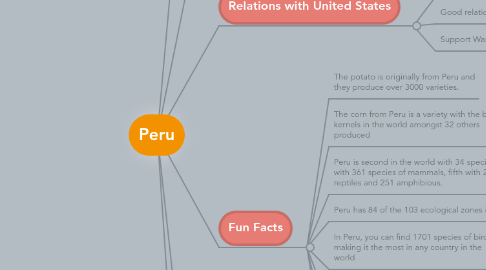
1. Modern History
1.1. 1969-1975
1.1.1. Peru implemented one of Latin America’s most radical agrarian reforms, comparable only to the magnitude of the agrarian reforms developed by the Mexican, Cuban and Nicaraguan revolutions.
1.2. 1980-1992
1.2.1. Many guerrilla groups formed all over Latin America
1.2.2. Violence was central to its political action and idea of destroying the “old order” to install a new one
1.2.3. The Shining Path started operations in the 1980s and -- by the end of the decade -- controlled much of Peru’s central and southern countryside and maintained a large presence in Lima’s outskirts.
1.2.3.1. A Truth and Reconciliation Commission concluded that at least 69,280 people died or disappeared between 1980 and 2000 as a result of the armed conflict.
1.2.3.2. The commission attributed about 54% of the casualties to the Shining Path and roughly one third to the government security forces.
1.3. 1990-2000
1.3.1. Alberto Fujimori appealed to voters as an outsider instead of part of the political establishment, leading to his election as president in 1990.
1.3.1.1. Once in power, he faced two formidable challenges: an economy in ruins and a country fighting a bloody insurgency driven by terrorist actions against civilians
1.3.2. The economy stabilized in a relatively short period of time, although at a huge social cost
1.3.2.1. Inflation dropped to single digits and has remained this way since.
1.4. 2001-2011
1.4.1. under the governments of President Alejandro Toledo (2001-2006) and Alan Garcia (2006-2011), Peru has enjoyed an impressive economic recovery
1.4.2. From 2001 to 2010, GDP grew at an average of 5.7% and inflation grew only at 2.4%
1.5. Now
1.5.1. Peru now has the most developed microfinance industry in Latin America and the most developed agricultural cooperatives involved in fair trade.
2. Politics
2.1. Turbulent Political History
2.1.1. President Alan Garcia (1985-1990) caused hyperinflation
2.1.2. Alberto Fujimori took over in 1990
2.1.2.1. Took over military and quelled "The Shining Path"
2.1.2.2. Later had to flee country
2.1.2.3. Sentenced to 25 years in prison for "crimes against humanity"
2.1.3. Valentin Paniagua (2000-2001) stabilized government
2.1.4. Alejandro Toledo (2001-2006) established free trade with US
2.1.5. Alan Garcia came back, but protests about the conditions of the poor kept him from reelection
2.1.6. Ollanta Humala then won and is current president
3. Relations with United States
3.1. Diplomatic relations were first established in 1827
3.2. Good relations
3.3. Support War against Drugs
4. Fun Facts
4.1. The potato is originally from Peru and they produce over 3000 varieties.
4.2. The corn from Peru is a variety with the biggest kernels in the world amongst 32 others produced
4.3. Peru is second in the world with 34 species of primates, third with 361 species of mammals, fifth with 297 species of reptiles and 251 amphibious.
4.4. Peru has 84 of the 103 ecological zones in the world
4.5. In Peru, you can find 1701 species of birds, making it the most in any country in the world
4.6. You can find 28 different climates in Peru, making it to be one of the 5 biggest biodiversities in the world.
4.7. Two-thirds of Peru is covered in prime Amazon Rain Forest
4.8. Peru is home to the highest sand dune in the world
4.8.1. Cerro Blanco located in the Sechura Desert near the Nazca Lines measures 3,860 feet (1,176 meters) from the base to the summit
5. Tourist Attractions
5.1. Hyacachina
5.1.1. a tiny oasis town surrounding a small natural lake and itself surrounded by towering sand dunes
5.1.2. Once a playground for the Peruvian elite, these days Huacachina mostly attracts international tourists.
5.1.3. The big draw here is the opportunity to sand board and taking dune buggy rides on the sand dunes
5.2. Nazca Lines
5.2.1. located between the towns of Nazca and Palpa along the northern Pacific coast
5.2.2. Created between 200 BC and 700 AD the figures range from simple lines to stylized spiders, monkeys, fish, llamas, lizards and human figures.
5.2.3. The lines were created on such a large scale that it wasn’t until the 1920′s, when Peruvian airlines started to fly from Lima to Arequipa, that they were recognized as figures.
5.2.4. Hotels and tour agents in Nazca offer round flights in a Cessna to view the lines
5.3. Colca Canyon
5.3.1. canyon of the Colca River, in the Andes mountain range, in southern Peru. It is more than twice as deep as the Grand Canyon, but the canyon’s walls are less steep
5.3.2. The big attraction here, in addition to the awesome sights, are the Andean condors.
5.3.2.1. The condors can be seen at fairly close range as they float on the rising thermals.
5.4. Machu Picchu
5.4.1. One of the most beautiful and impressive ancient sites in the world, Machu Picchu is the undisputable nr 1 among the top tourist attractions in Peru.
5.4.2. The “Lost City of the Incas” is invisible from the Urubamba Valley below and completely self-contained, surrounded by agricultural terraces and watered by natural springs.
5.4.3. Although known locally, Machu Picchu was largely unknown to the outside world before being rediscovered in 1911 by historian Hiram.
6. Economy/Natural Resources
6.1. Due to varied climates, Peru exports a wide variety of goods
6.1.1. Andes has ore
6.1.2. Pacific Ocean has fish
6.1.3. Also exports energy, textiles, chemicals, and agricultural products
